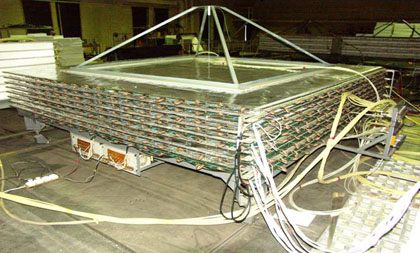Real-time URAGAN data are available now!
Muon hodoscope URAGAN is now under operation in NEVOD Laboratory (Moscow Engineering Physics Institute). The hodoscope (see Figure) is composed of separate horizontal supermodules, each with an area of 11.5 m2, located on the cover (173 m above sea level) of water Cherenkov detector NEVOD. Each supermodule consists of eight layers of gas-discharge chambers equipped with X-Y system of external readout strips (2560 X + 2304 Y channels for supermodule) with steps of 1.0 and 1.2 cm, respectively. The layers alternate with continuous 5 cm thick foam plastic sheets. Each layer is an assembly of 20 streamer tube chambers, which consist of 16 tubes with cross-section of 9x9 mm2 and a length of 3.5 m, placed in one plastic housing. The chamber operation in the limited streamer mode is provided by the choice of a specific three-component gas mixture (argon + CO2 + n-pentane) and appropriate operating voltage. Charged particles (muons) penetrating through gas chambers cause streamer discharge which induces signals on X and Y strips. Each supermodule is located on an individual mobile platform, which allows to change its position with respect to other supermodules and the detecting system of the water Cherenkov detector NEVOD.

The supermodules of muon hodoscope URAGAN.
The triggering and data acquisition system of the hodoscope has a distributed multi-level architecture. The modular organization makes it possible to easily change the configuration and develop the system with addition supermodules. The basic element of the data acquisition system of the hodoscope is a specially developed fast readout card, which provides amplification, discrimination, formation, storage of signals and serial data transfer from 16 strips. Each supermodule requires 160 X and 144 Y data acquisition cards and 8 cross-cards to connect signal lines and supply power. The trigger signal in a plane is formed by data acquisition cards at triggering of any X-channel in this plane. The condition for triggering of the supermodule measurement system is the coincidence at least four trigger signals from different planes during 300 ns. The average count rate of one supermodule is about 1700 events per second.
The supermodule response contains information about triggered strips in each of the X- and Y-projections. The track parameters (two projection angles) are reconstructed in real time and are accumulated in a 2D directional array during 1 minute interval. Such data array (matrix) is a "muon photograph" of the upper hemisphere during a 1-min exposure. Reconstruction algorithm provides a high spatial and angular accuracy of muon detection (1 cm and about 0.8°, respectively) in a wide range of zenith angles (from 0° to 84°). To reduce reconstruction errors only tracks passing within the areas of upper and bottom planes are taken into account (that is, tracks crossing all 8 planes of the SM). This demand decreases SM event rate approximately by 13 %. Efficiency of reconstruction is greater than 90 % and one-minute matrices contain about 8x104 reconstructed events.
More detailed information about muon hodoscope URAGAN can be found in following papers:
- D. V.Chernov et al. Experimental setup for muon diagnostics of the Earth's atmosphere and magnetosphere (the URAGAN project). Proc. 29th ICRC, Pune, 2005. V.2. P. 457.
- N. S. Barbashina et al. Wide-Aperture Muon Detector for Diagnostics of the Earth’s Atmosphere and Magnetosphere. Bull. RAS: Physics, V. 71(7) P. 1044 (2007).
Real-time URAGAN data
|